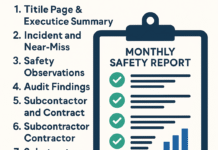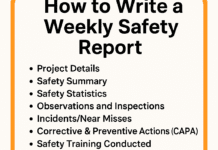
How To Develop Safety Policy | Safety Policy Development Guidelines
Introduction
Creating a safety policy might sound like a daunting task, but it’s absolutely essential for any organization. Why? Because a well-crafted safety policy not only keeps your employees safe but also boosts productivity and morale. So, let’s dive into how you can develop a safety policy that works!
Understanding Safety Policies
Definition of Safety Policies
Safety policies are formal documents that outline an organization’s commitment to maintaining a safe and healthy work environment. They serve as a roadmap for identifying, managing, and mitigating workplace hazards.
Purpose and Benefits of Safety Policies
The main purpose of a safety policy is to prevent accidents and injuries. But the benefits go beyond safety. A strong safety policy can lead to improved employee morale, reduced absenteeism, and even lower insurance premiums.
Key Elements of a Safety Policy
Statement of Intent
This is your safety policy’s mission statement. It should clearly state your organization’s commitment to safety and health.
Responsibilities
Define who is responsible for what. This includes everyone from top management to individual employees.
Safe Working Practices
Outline the procedures that must be followed to ensure safety. This could include anything from how to handle hazardous materials to proper ergonomics.
Emergency Procedures
Detail the steps to take in case of an emergency, like a fire or chemical spill.
Steps to Develop a Safety Policy
Step 1: Conduct a Risk Assessment
Identify potential hazards in your workplace. This involves looking at all aspects of your operations and pinpointing what could go wrong.
Step 2: Define Clear Objectives
What do you want to achieve with your safety policy? Your goals should be specific, measurable, achievable, relevant, and time-bound (SMART).
Step 3: Assign Responsibilities
Everyone in your organization should know their role in maintaining safety. This includes management, employees, and safety officers.
Step 4: Establish Safety Procedures
Develop standard operating procedures (SOPs) and emergency response plans. Make sure these are easily accessible and understood by all employees.
Step 5: Provide Training and Resources
Training is crucial. Ensure that employees know how to work safely and understand the safety procedures. Provide necessary safety equipment and resources.
Step 6: Implement and Communicate the Policy
Communicate your safety policy clearly and effectively. Use multiple channels to ensure everyone is on the same page.
Step 7: Monitor and Review the Policy
Regularly review and update your safety policy. Conduct safety audits and gather feedback to make continuous improvements.
Conducting a Risk Assessment
Identifying Hazards
Look at every part of your operation to find potential hazards. This can include physical, chemical, biological, and ergonomic hazards.
Evaluating Risks
Assess the likelihood and severity of each hazard. This helps in prioritizing which risks need the most attention.
Prioritizing Actions
Focus on the most significant risks first. Implement control measures to eliminate or reduce these risks.
Defining Clear Objectives
Setting Achievable Goals
Your safety objectives should be realistic and attainable. Set specific targets, like reducing workplace injuries by a certain percentage.
Aligning Objectives with Organizational Goals
Ensure that your safety objectives support your overall business goals. This alignment helps in gaining management support and resources.
Assigning Responsibilities
Role of Management
Management should lead by example and provide the necessary support and resources for safety initiatives.
Role of Employees
Employees should follow safety procedures and report any hazards or incidents.
Role of Safety Officers
Safety officers should oversee the implementation of the safety policy and conduct regular inspections and training.
Establishing Safety Procedures
Standard Operating Procedures (SOPs)
Create clear and concise SOPs for all tasks. Ensure they are easily accessible and understood by everyone.
Emergency Response Procedures
Develop plans for different types of emergencies. Conduct regular drills to ensure everyone knows what to do.
Reporting and Documentation
Establish a system for reporting accidents, incidents, and near-misses. Keep detailed records to identify trends and areas for improvement.
Providing Training and Resources
Safety Training Programs
Implement comprehensive training programs for all employees. This should include initial training and regular refresher courses.
Access to Safety Equipment and Resources
Ensure that employees have access to the necessary safety equipment and resources. This includes personal protective equipment (PPE), safety data sheets (SDS), and first aid supplies.
Continuous Learning and Development
Encourage continuous learning and development. Stay updated with the latest safety standards and best practices.
Implementing and Communicating the Policy
Effective Communication Strategies
Use multiple channels to communicate your safety policy. This could include emails, meetings, posters, and training sessions.
Ensuring Employee Buy-In
Involve employees in the development of the safety policy. This helps in gaining their buy-in and commitment.
Monitoring and Reviewing the Policy
Regular Safety Audits
Conduct regular safety audits to identify areas for improvement. Use the findings to update your safety policy.
Reviewing and Updating Policies
Regularly review and update your safety policy. Ensure that it remains relevant and effective.
Overcoming Common Challenges
Resistance to Change
Change can be difficult. Address resistance by communicating the benefits of the safety policy and involving employees in the process.
Limited Resources
Work within your budget. Prioritize the most critical areas and seek external funding or support if necessary.
Maintaining Consistency
Ensure that safety procedures are consistently followed. Conduct regular training and audits to maintain high standards.
Best Practices for Safety Policy Development
Involving Employees in Policy Development
Involve employees in the development of the safety policy. This helps in gaining their input and commitment.
Keeping Policies Simple and Clear
Keep your safety policy simple and clear. Avoid jargon and ensure that everyone understands it.
Continuous Improvement
Continuously improve your safety policy. Regularly review and update it based on feedback and changing circumstances.
Developing a safety policy is crucial for ensuring a safe working environment across different industries like construction, oil & gas, and manufacturing. Here are sample guidelines for each industry:
Construction Safety Policy
Title: Construction Safety Policy
Purpose: The purpose of this policy is to ensure the safety and well-being of all employees, contractors, and visitors on our construction sites.
Guidelines:
- Safety Commitment: Our company is committed to maintaining the highest standards of safety in all construction activities.
- Responsibilities:
- Management: Will provide leadership and resources to implement and maintain safety programs.
- Supervisors: Will ensure that safety measures are followed on-site and provide necessary training.
- Employees: Must comply with safety rules, report hazards, and participate in safety training.
- Risk Assessment:
- Conduct regular risk assessments and implement control measures to mitigate identified risks.
- Ensure that all equipment and machinery are inspected and maintained regularly.
- Training and Awareness:
- Provide regular safety training to all employees, including emergency procedures and hazard recognition.
- Promote a culture of safety through awareness campaigns and toolbox talks.
- Incident Reporting and Investigation:
- Establish procedures for reporting near misses, accidents, and incidents promptly.
- Conduct thorough investigations to identify root causes and implement corrective actions.
- Compliance:
- Comply with all relevant health and safety legislation, regulations, and industry standards.
- Regularly review and update the safety policy to reflect changes in operations or regulations.
Oil & Gas Industry Safety Policy
Title: Oil & Gas Industry Safety Policy
Purpose: This policy aims to ensure the safety of personnel, protection of the environment, and efficient operations within our oil and gas operations.
Guidelines:
- Safety Culture: Foster a safety-first culture where every employee is responsible for their safety and the safety of others.
- Operational Safety:
- Conduct rigorous risk assessments before commencing any operation.
- Implement and maintain strict safety protocols for drilling, extraction, transportation, and refining activities.
- Emergency Preparedness:
- Develop and regularly test emergency response plans for oil spills, fires, and other potential hazards.
- Ensure that all personnel are trained in emergency procedures and first aid.
- Health and Environment:
- Monitor and control exposure to hazardous substances to protect the health of employees and minimize environmental impact.
- Implement measures to conserve resources and reduce waste generation.
- Continuous Improvement:
- Regularly review safety performance and seek ways to improve safety practices.
- Encourage feedback from employees to identify potential hazards and areas for improvement.
- Compliance and Standards:
- Adhere to all applicable regulatory requirements and industry standards.
- Conduct internal audits to ensure compliance with safety policies and procedures.
Manufacturing Industry Safety Policy
Title: Manufacturing Industry Safety Policy
Purpose: This policy aims to establish and maintain a safe working environment for all employees involved in manufacturing operations.
Guidelines:
- Safety Leadership: Demonstrate visible commitment to safety from top management to frontline supervisors.
- Risk Management:
- Identify and assess workplace hazards through regular inspections and risk assessments.
- Implement engineering controls, safe work procedures, and personal protective equipment (PPE) as necessary.
- Training and Competence:
- Provide comprehensive safety training for all employees, including new hires and contractors.
- Ensure that employees are competent to perform their tasks safely and effectively.
- Ergonomics and Well-being:
- Promote ergonomic principles to reduce musculoskeletal disorders and improve workplace comfort.
- Support employee well-being through wellness programs and access to health resources.
- Safety Communication:
- Maintain open channels of communication for reporting hazards, near misses, and safety suggestions.
- Conduct regular safety meetings and toolbox talks to reinforce safety awareness.
- Continuous Improvement:
- Monitor safety performance metrics and implement corrective actions to prevent incidents.
- Encourage employee involvement in safety initiatives and recognize contributions to safety improvements.
- Legal Compliance:
- Comply with all applicable health and safety legislation, regulations, and industry standards.
- Stay informed about regulatory updates and incorporate changes into the safety management system.
Conclusion
Developing a safety policy is crucial for maintaining a safe and healthy work environment. By following the steps outlined in this guide, you can create a robust safety policy that protects your employees and supports your organizational goals. Remember, a strong safety policy is a continuous journey of improvement and commitment.
Emergency Evacuation Procedures
Emergency Evacuation Plan for Construction Site
Emergency Evacuation Plan for Factory
Emergency Evacuation Plan Example
FAQs
What is a Safety Policy?
A safety policy is a formal document that outlines an organization’s commitment to maintaining a safe and healthy work environment.
How Often Should Safety Policies be Reviewed?
Safety policies should be reviewed at least annually or whenever there are significant changes in the workplace.
Who is Responsible for Enforcing Safety Policies?
Everyone in the organization is responsible for enforcing safety policies, but specific roles may include management, employees, and safety officers.
What Should be Included in a Safety Policy?
A safety policy should include a statement of intent, responsibilities, safe working practices, and emergency procedures.
How Can Companies Ensure Compliance with Safety Policies?
Companies can ensure compliance by providing training, resources, and regular audits, and by fostering a culture of safety.






















great sit and app